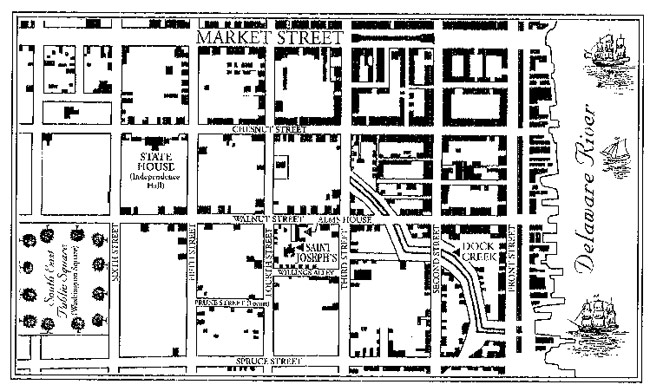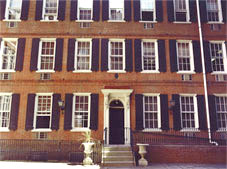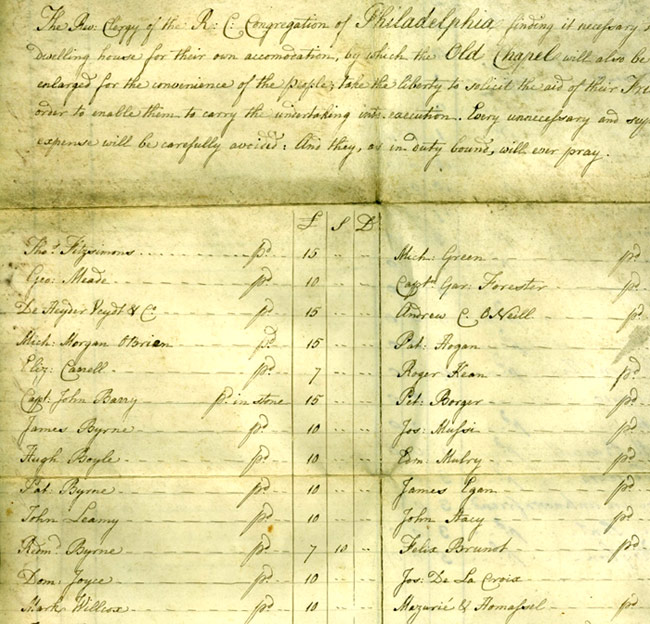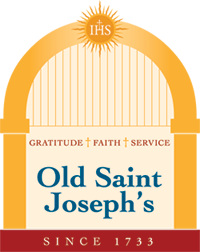18th Century
Old St. Joseph’s In The 18th Century
Old St. Joseph’s owes its existence to English Jesuits, who first arrived in Maryland in 1634. Founded by the Catholic Calverts as a colony where “mutual love and amity” would prevail among people of differing religious belief, the Calvert’s rule was periodically beset with opposition from Protestant settlers and from London. Twice the colony reverted to royal governance when the Calvert’s rule was overthrown. Finally, when the Church of England was established by law in Maryland in 1702, an Act to Prevent the Spread of Popery was passed in 1704, and Catholics were fully disenfranchised in 1718, the quasi-toleration Catholics had enjoyed came to an end. Only economic considerations made the celebration of Mass in private homes allowable after 1704, when London’s Board of Trade warned Queen Anne that “a rigorous execution of the act would.tend to depopulate Your Majesty’s profitable colony.” Private Masses were celebrated in chapels on the Jesuit estates and in private chapels maintained by the Catholic gentry until after the Revolution. In response to the restrictions on the practice of Catholicism in Maryland, the Jesuits expanded their missionary efforts in 1704 from southern Maryland to Old Bohemia, Cecil County, a few miles from the Pennsylvania border. From this base, missions were established in Pennsylvania and Delaware, and in 1729 a permanent priest, Rev. Joseph Greaton, S.J., arrived in Philadelphia where William Penn’s Charter of Privileges for Pennsylvanians guaranteed religious and civic freedom to “all who worshiped one God” – not just Catholics. Father Greaton built the first chapel in 1733. By the summer of 1734, the matter of a public Mass was brought before the Provincial Council, where it was reported that there was “no small concern to hear that a House lately built in Walnut Street.was sett apart for the Exercise of the Roman Catholick Religion and it is commonly called the Romish Chappell . where Mass [is] openly celebrated by a Popish priest.contrary to the Laws of England.” After deliberations by the Council, the civil and religious freedom set out in Penn’s Charter of Privileges – the constitution of the colony – took precedence over the Penal Laws of England, and the chapel remained, a testament to Penn’s “Holy Experiment.” As the birthplace of the Declaration of Independence and the Constitution, Philadelphia was also the seedbed of Enlightenment values that shaped America’s religious history. The Enlightenment ideals of religious tolerance and freedom of conscience contained in William Penn’s 1701 Charter of Privileges made the Quaker city unique. No where else could Catholics enjoy public worship and growth to the extent possible in 18th century Philadelphia. By 1785, the future Bishop John Carroll reported to Rome that there were 1,000 Catholics in Philadelphia and 2,000 in the surrounding region. Old St. Joseph’s was the first urban Catholic church in the British Colonies. No Catholic churches were founded in New York, Boston or New York until after the American Revolution. Old St. Joseph’s sacramental records, among the earliest in the nation, record 8,850 baptisms before 1810. Old St. Joseph’s was also the home base for Jesuit circuit riders who expanded the Philadelphia mission to both English- and German-speaking colonists throughout the Middle Atlantic States. Eight Catholic dioceses (Allentown, Harrisburg, PA; Camden, Trenton, Patterson, Metuchen, NJ; Wilmington, DE; New York, NY.) trace their heritage to Jesuit missionaries from Old St. Joseph’s. Throughout the 18th century, under the leadership of Jesuit Fathers Joseph Greaton, Robert Harding, Ferdinand Farmer, and their successors – men gifted with apostolic fervor and significant intellectual and personal talents – Old St. Joseph’s became an integral part of the city’s civic, cultural and religious life. Philadelphia’s early Catholics shared similar backgrounds and values with their Anglo-American neighbors. Protestants attended Catholic services and contributed to church building funds and they often intermarried: 22% of all baptisms before 1800 were performed for families in which one of the parents was not of the Catholic faith.

Clarkson-Biddle Map of Philadelphia, 1762. (detail)
Fr. Harding, Old St. Joseph’s second pastor, built a larger church in 1757, and St. Mary’s nearby in 1763. (Old St. Josephs – St. Mary’s was one parish until the 1830s.) Harding joined Quaker Anthony Benezet in caring for the destitute Acadians, exiled by the British from Nova Scotia, who arrived in Philadelphia in 1755. (Their story is told in Longfellow’s epic poem Evangeline.) He was one of the first subscribers to the building of America’s first hospital, Pennsylvania Hospital, and a founder of the Sons of St. George for the Assistance of Englishmen in Distress. The Anglican rector of Christ Church wrote of Harding that “he is much esteemed by all denominations in the city, for his prudence, his moderation, his known attachment to English liberties.” In an expression of Catholic loyalty to Richard Penn in 1771, Harding assured the new governor that the Roman Catholics are “grateful to your Honorable Family, for the many privileges, religious and civil, we have enjoyed.” Penn replied, “You may depend upon a continuation of the same religious and civil privileges under my administration.” Harding died in 1772 after 23 years as pastor, “A gentleman who, for the integrity of his life is greatly lamented.” Fr. Ferdinand Farmer, Harding’s successor, became a Trustee of the University of Pennsylvania and both he and Harding were members of the American Philosophical Society. Farmer led the list of nine signers of the Congratulatory Address by the Clergy, Gentlemen of the Law, and Physicians of Philadelphia who welcomed George Washington to the city in 1783, praising his support of the cause of “virtue, philosophy and the sciences.” All the clergy of the city, members of the American Philosophical Society, professors and trustees of the University, and many leading citizens attended Farmer’s funeral in 1786. He is buried beneath the altar at Old St. Joseph’s. Farmer was followed by Rev. Robert Molyneux, S.J., who served St. Joseph’s – St. Mary’s during the Revolution. He established warm relations with the diplomatic corps in the city. (He gave English lessons to the French minister, Anne-Cesar de la Luzerne.) He also participated in the first Catholic celebration of the 4th of July in 1779 at St. Mary’s and the Te Deum held for the victory at Yorktown in 1781. Molyneux is also the father of Catholic publishing in America. Under his direction the first Catholic prayer books in America were published in Philadelphia. He also directed the publication of the first hymnbook of Catholic music, John Aitken’s Compilation of Litanies Vespers Hymns and Anthems Sung in Catholic Churches, published in Philadelphia in 1787. Molyneux later became president of Georgetown University. Rev. Laurence Graessl, S.J., from Germany, welcomed refugees, white and black, from the 1791-93 Revolution in Santo Domingo. Old St. Joseph’s became their parish; numerous baptisms and marriages of this group are found in our sacramental records of the 1790s. Old St. Joseph’s priests ministered to the victims of Philadelphia’s 1793 Yellow Fever epidemic, which took the lives of 335 Catholics and three priests at Old St. Joseph’s, including Fr. Graessl, who had been nominated as coadjutor to Bishop John Carroll. Four thousand Philadelphians died, 10% of the population, leaving many orphaned children. Fr. Leonard Neale, S.J., later the second bishop of Baltimore, established the first Catholic orphanage to care for such children.

Rectory, former clergy house, 1789, Laird Bindrim, SJUP
In 1789, a substantial clergy house was erected on the site. The clergy house was attached to and perpendicular to the 1757 church, 52 X 26 feet, of brick set in Flemish bond, with seven bays. It contained two floors with a dormered attic and a basement kitchen. Two floors of the clergy house remain within the present rectory. The building is attributed to James Corkrin, a pew holder at St. Mary’s and a member of the Carpenters’ Company. It was designed in the Federal style with a handsome fan-lighted entrance, intricately carved mantles and window surrounds, and spacious parlors and bed chambers. (The original exterior fanlight, reinstalled today above an interior hallway door, was preserved.) Over 800 Philadelphia Catholics served in the Revolutionary Army and Navy, and several Philadelphia Catholics achieved prominence during that time: General Stephan Moylan, patriot officer on Washington’s staff, George Meade, who outfitted privateers and raised money to feed the troops at Valley Forge; Thomas Fitzsimons, army captain and later signer of the Constitu- tion; and Commodore John Barry, U.S. Navy hero. These leaders head the list of 114 contributors to the building of the 1789 clergy house. Catholics in the new nation moved quickly to vote and run for political office. Bishop John Carroll, along with Senator Charles Carroll, and Congressmen Daniel Carroll, Dominic Lynch and Thomas Fitzsimons of the new Congress addressed President George Washington on behalf of the Catholics of the country. They took “the opportunity, not merely of presaging the happiness to be expected under your administration, but of bearing testimony to that which we experience already.” Washington replied, “I hope ever to see America among the foremost Nations in examples of liberality.And may the members of your Society in America, animated alone by the pure spirit of Christianity, and still conducting themselves as the faithful subjects of our free Government, enjoy every temporal and spiritual felicity.”

Subscription List to build clergy house, 1789. OSJ archives. (detail)
Acknowledgement and thanks to Martin I.J. Griffin, M. Maury Walton, Eugene Gallagher, S.J., and John M. Daley, S.J., for essays or pamphlet histories of Old St. Joseph’s.
Mass Times
Sunday at 7:30 AM, 9:30AM, 11:30 AM
Tues., Wed., & Thurs. at 12:05 PM
